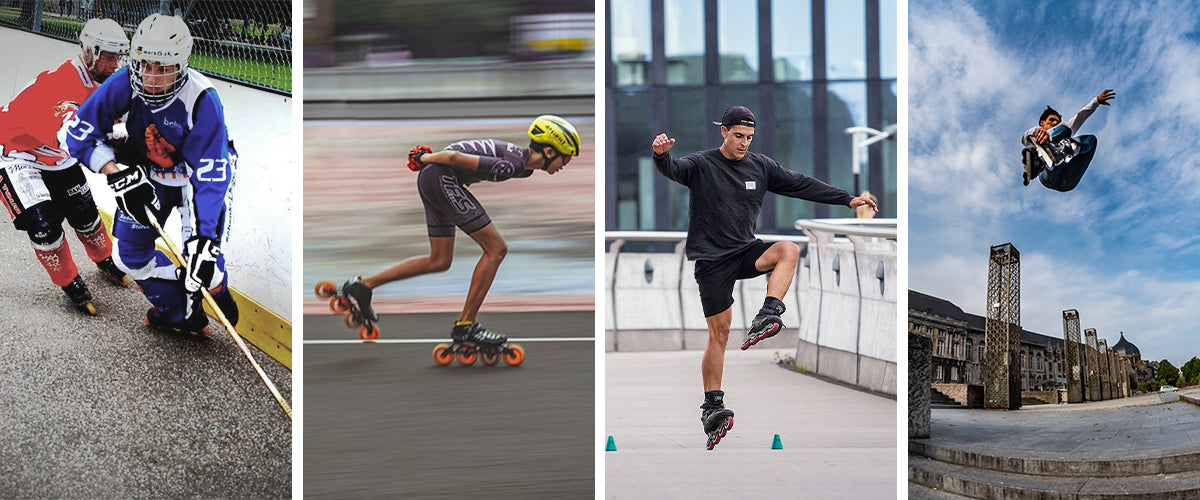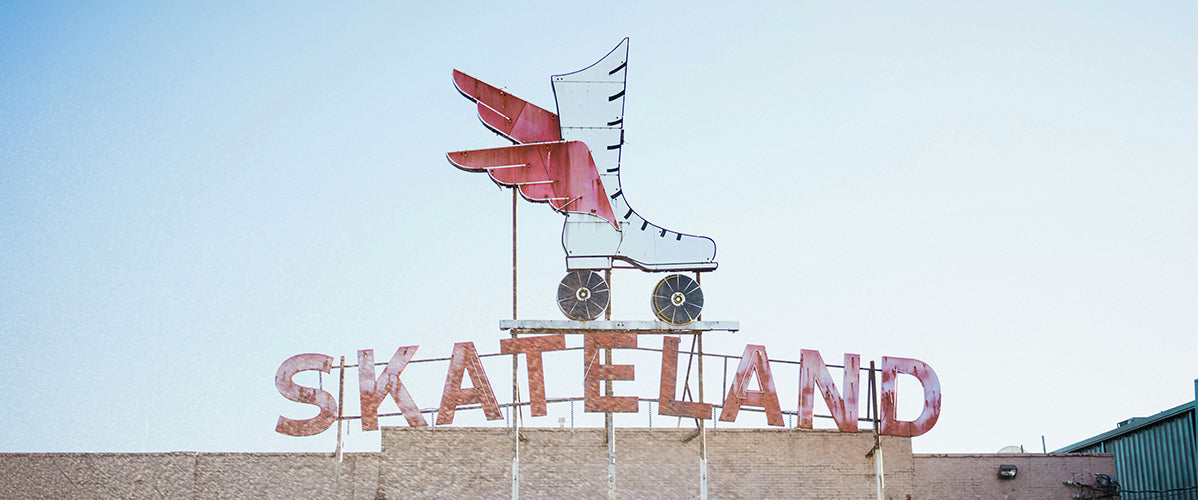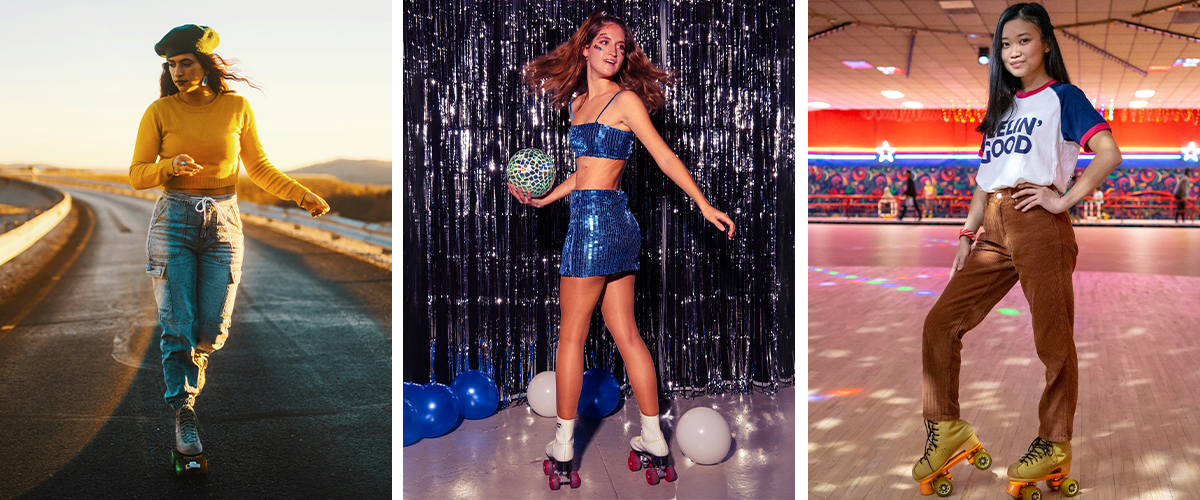The origins of roller skating
The roller skate is an accessory that has stood the test of time and continues to seduce young and old alike. Its origins date back to the 18th century, when Belgian inventor John Joseph Merlin designed the first roller skates by attaching metal wheels to a wooden board. Since then, roller skating has had a long and rich history. In the early days, roller skates were mainly used for artistic performances. It was only in the 19th century that the practice diversified, with the creation of roller clubs around the world, notably in the United States and Europe.

The evolution of rollerblading in the 20th century
Over the years, rollerblading has gradually established itself as a fun and environmentally-friendly means of locomotion. It has also been used in a variety of sporting disciplines, including :
Roller Hockey: A variant of traditional field hockey played on roller skates. Teams, generally made up of five players, compete to score goals using a ball and sticks.The Roller Speed Race : Showcases skaters' speed and endurance. On specially designed tracks, participants engage in long-distance races ranging from sprints to marathons.
Roller Slalom: An artistic discipline that involves performing technical movements by slaloming between cones or obstacles. Skaters link acrobatic figures, rotations and tight turns with elegance and precision.
Roller Derby: A team sport on roller skates, played on an oval track. Two competing teams battle it out, each team having a player designated as a "jammer" whose job it is to score points by overtaking the opposing players. Blockers defend their jammer while trying to block the opposing jammer.
Freestyle Rollerblading: Visit freestyle rollerblading encompasses various artistic and acrobatic disciplines on roller skates. These include street roller figures, jumps, slides, tricks and sometimes even roller dances. Freestyle skaters push the limits of creativity, using the urban environment as their playground.
To find out more about the different roller sports, visit our article: The different roller sports.  It was also during the 20th century that roller skating underwent a number of technological developments that improved the comfort, safety and performance of skaters. The main advances are :
It was also during the 20th century that roller skating underwent a number of technological developments that improved the comfort, safety and performance of skaters. The main advances are :
- The advent of quad roller skates (4 wheels per skate)
- The creation of inline skates, also known as rollerblades
- The use of lightweight, resistant materials such as plastic or carbon fiber for skate shells
- The adoption of more secure fastening systems that can be adjusted to the wearer's foot.
The success of rollerblading in the 80s and 90s
The 1980s and 1990s were a pivotal period for inline skating, marking a time when the activity enjoyed exceptional success, becoming a cultural and sporting phenomenon in its own right. The roller-skating craze was considerably stimulated by the representation of roller-skating in the media, particularly in the popular films and TV series of the time. Iconic productions such as "Xanadu" and "Roller Boogie" helped anchor the image of roller skating in popular culture. These cinematic works captivated audiences by showcasing impressive choreography, thrilling competitions and dynamic visual aesthetics, elevating rollerblading to a hip and entertaining activity.This era also saw the emergence of rollerblading competitions on an international scale, providing a platform for talented skaters to demonstrate their agility and virtuosity. Events such as the World Roller Championships attracted worldwide attention, sparking growing interest in the discipline. These competitions have helped to raise skill levels and broaden the scope of rollerblading as a competitive sport.
The roller-skating craze was considerably stimulated by the representation of roller-skating in the media, particularly in the popular films and TV series of the time. Iconic productions such as "Xanadu" and "Roller Boogie" helped anchor the image of roller skating in popular culture. These cinematic works captivated audiences by showcasing impressive choreography, thrilling competitions and dynamic visual aesthetics, elevating rollerblading to a hip and entertaining activity.This era also saw the emergence of rollerblading competitions on an international scale, providing a platform for talented skaters to demonstrate their agility and virtuosity. Events such as the World Roller Championships attracted worldwide attention, sparking growing interest in the discipline. These competitions have helped to raise skill levels and broaden the scope of rollerblading as a competitive sport.
The advent of adjustable roller skates has played a crucial role in the democratization of roller skating. These new models offered greater accessibility by allowing skaters to adjust the size of the skates to suit their growth. This feature eliminated the constraints associated with children's rapid growth, paving the way for wider and earlier participation in roller sports.
The 80s and 90s were also the birthplace of brands specializing in the design and distribution of roller equipment. These companies played an essential role in offering quality products tailored to the specific needs of skaters. The variety of models, styles and features has helped to diversify the rollerblading experience, allowing skaters to choose equipment to suit their individual preferences.
The creation of dedicated tracks and skateparks has provided a safe and stimulating playground. These facilities have encouraged the growth of the rollerblading community by providing dedicated spaces for practising, learning and perfecting skills. The growth of skateparks has also encouraged the emergence of disciplines such as street rollerblading, further enriching the diversity of practices.
 Rollerblading's success in these years stems from a combination of factors, from media representation to the democratization of equipment. These decades have left a lasting legacy, contributing to the durability and continuing popularity of roller skating worldwide.
Rollerblading's success in these years stems from a combination of factors, from media representation to the democratization of equipment. These decades have left a lasting legacy, contributing to the durability and continuing popularity of roller skating worldwide.
Rollerblading in the 21st century
Over the course of the 21st century, rollerblading has continued to evolve and maintain its place as a diversified sport, although its popularity has fluctuated. Despite periods when other activities may have attracted more attention, rollerblading remains a practice appreciated for its many benefits, both physical and social.
The diversification of roller sports disciplines has played a key role in maintaining and renewing the sport in the 21st century. The introduction of freestyle roller skating, for example, brought a new dimension to the sport, emphasizing creativity, artistic expression and the execution of acrobatic figures. The discipline gained recognition with the organization of dedicated international competitions, offering skaters a platform to showcase their innovative skills and stimulating the development of this branch of roller sports. In addition to freestyle roller skating, other disciplines have also undergone significant development. The roller derbyroller derby, for example, has grown in popularity in the 21st century, with significant growth in leagues and competitions around the world. Roller derby communities have grown, attracting new participants and reinforcing roller's status as a competitive sport.
In addition to freestyle roller skating, other disciplines have also undergone significant development. The roller derbyroller derby, for example, has grown in popularity in the 21st century, with significant growth in leagues and competitions around the world. Roller derby communities have grown, attracting new participants and reinforcing roller's status as a competitive sport.
Rollerblading and the Olympic Games
The inclusion of rollerblading in the Olympic program at the Paris 2024 Games, marking its historic entry, is a significant milestone for this dynamic discipline. This recognition testifies to rollerblading's evolution as a serious, competitive sport on the global sporting landscape.
This Olympic recognition underlines not only the discipline's growth, but also its commitment to high sporting standards. Roller skaters can now aspire to compete at the highest level, alongside athletes from more traditional disciplines, in the prestigious setting of the Olympic Games.
The inclusion of rollerblading in the Olympic Games also illustrates how alternative and emerging sports can be a vehicle for connecting with new audiences and generations. It offers a unique opportunity for rollerblading to gain global exposure and inspire more people to get involved in the sport.
Roller Dance and other innovative practices
 New practices are regularly emerging, helping to renew interest in roller sports. Roller Dance, for example, is enjoying growing success, combining dance, music and roller skates. The third edition of the Passeurs de Lumière event in Quimper in December 2023 featured Roller Dance on the program. In conclusion, thanks to its versatility, adaptability and playfulness, roller skating has spanned the ages and appealed to different generations. From its modest origins as a simple show accessory to the Paris 2024 Olympic Games, it remains more than ever a popular and dynamic practice.
New practices are regularly emerging, helping to renew interest in roller sports. Roller Dance, for example, is enjoying growing success, combining dance, music and roller skates. The third edition of the Passeurs de Lumière event in Quimper in December 2023 featured Roller Dance on the program. In conclusion, thanks to its versatility, adaptability and playfulness, roller skating has spanned the ages and appealed to different generations. From its modest origins as a simple show accessory to the Paris 2024 Olympic Games, it remains more than ever a popular and dynamic practice.









